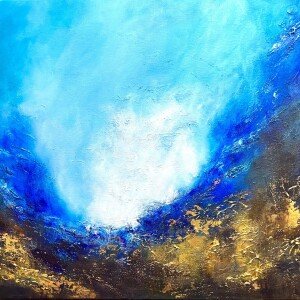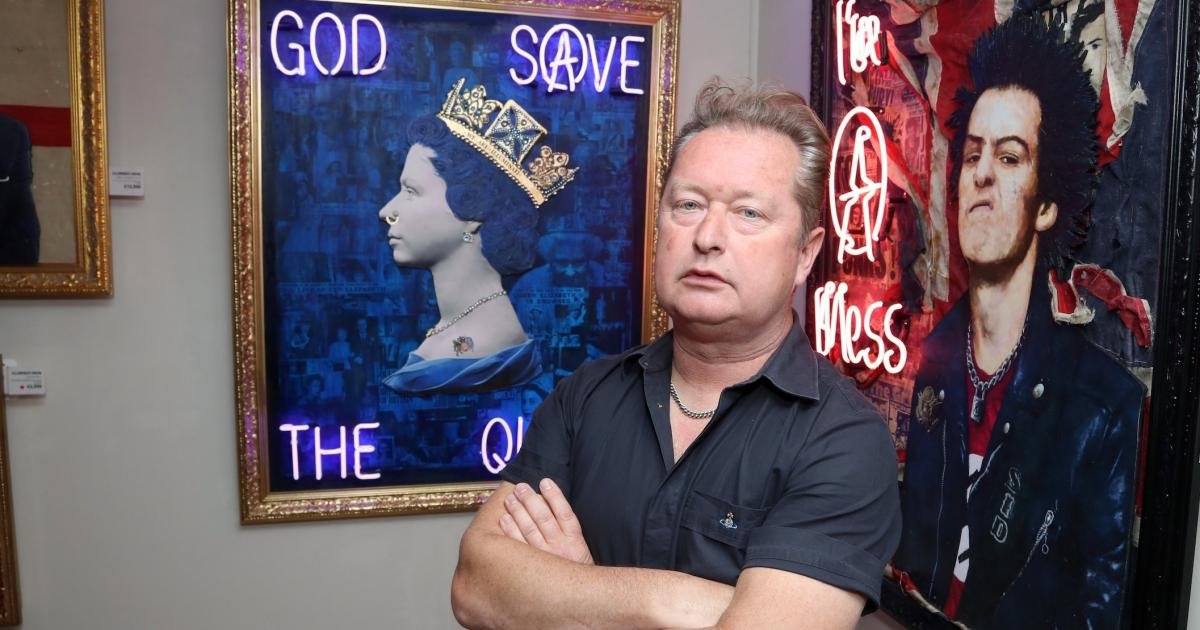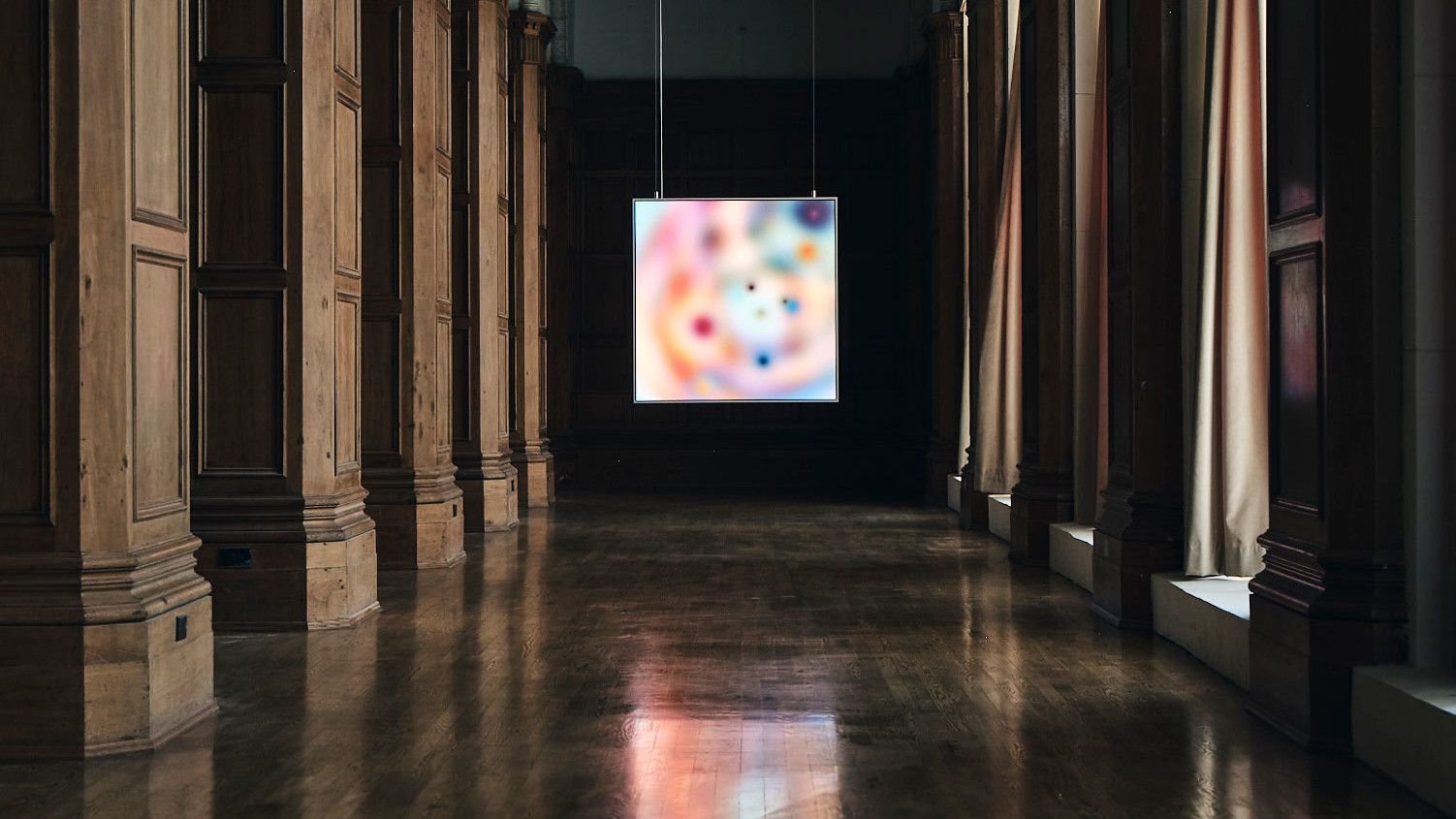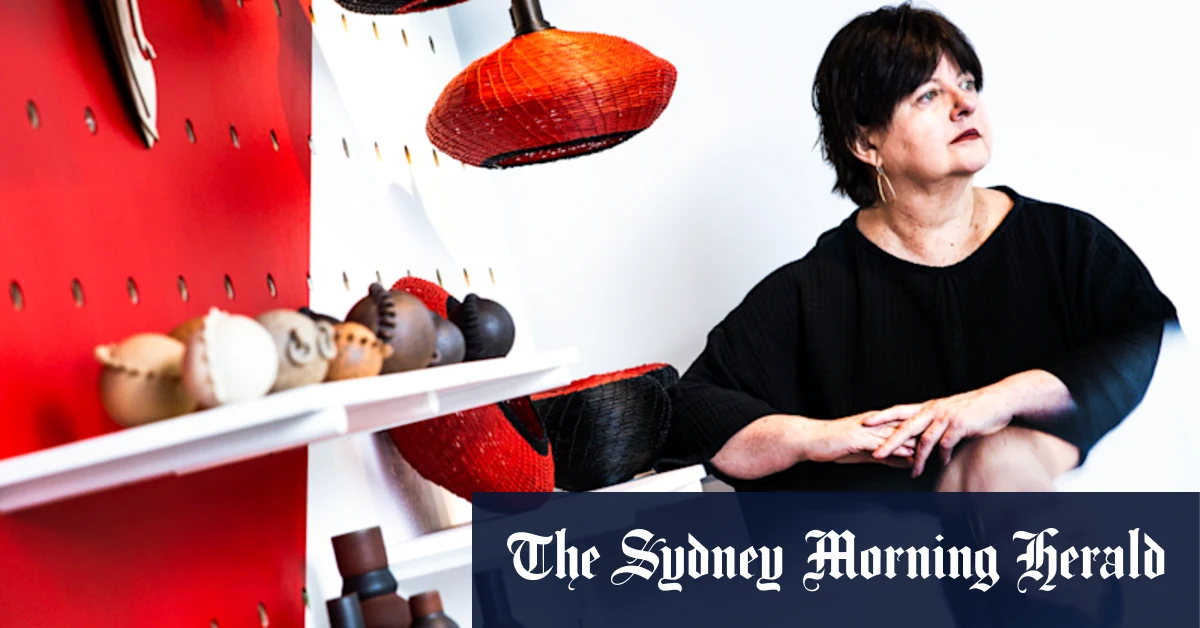While the Russian war against Ukraine is ongoing, Ukrainian culture is experiencing powerful reevaluation. The Ukrainian House in Kyiv (initially built in 1982 as the Lenin’s Museum) became a venue for unique large-scale exhibitions of Ukrainian art. The current exhibition, Material Matters, Ukrainian Art Textile (in Ukrainian, “material” also means fabric), presents more than 120 textile artworks of 60 artists сovering the last 100 years.


Serhiy Kolos. Shchedrivka (Christmas Folk Song). 1924. Cotton, hand weaving. National Museum of Decorative Art of Ukraine.
In the 1920s, Ukrainian art and culture thrived. This period was later called an Executed Renaissance because Stalin’s regime suppressed and exterminated many artists and writers. Serhiy Kolos was one of the artists fascinated by textiles. In 1925, he became a member of the Association for Revolutionary Art in Ukraine, according to which crafts were considered equally important to fine arts. He worked with textiles for most of his life. Some of his early works inspired by folk art are on display in Material Matters.


Portrait of Serhiy Kolos and his tapestry Bird and Dog. 1923. Wool, hand weaving. Collection of Viktor Rybachuk.
A significant part of the show consists of textiles of the 1960s-70s, a revival period after decades of Stalinist censorship. Socialist realism remained an official style, mostly in painting and sculpture, till the end of the USSR and served as state propaganda. The so-called “unofficial art” of the 1960s and 1970s flourished in decorative and monumental works — mosaics, textiles, ceramics, and stained glass. The stylization in the use of these media allowed for experimentation. Artists known as Sixtiers usually worked in both official and unofficial art, incorporating their experiments into works commissioned by the state. In the mid-1970s, after a decade of relative freedom, some artworks were censored and even destroyed after being accused of “nationalism”, “deviations from the principles of Socialist realism,” and “anti-Soviet propaganda”. Some artists were imprisoned, and some, like Alla Horska, were killed. Communist Party censors condemned religious and national connotations or a focus on suffering and insufficient optimism. Optimism meant glorifying the state and believing in the coming of communism.
However, many works of art from the 1960s and 1970s draw inspiration from other sources, such as nature and folk traditions, love and motherhood, historical figures, and events of the Ukrainian people’s struggle. Such works resonate with contemporary Ukrainians who assert their indigenous culture in opposition to imposed Russian colonial influence.
At Material Matters, Volodymyr Priadka’s hand-woven textiles draw on the symbolism of the seasons in the traditional culture of Ukrainian peasants. In his tapestry Spring (1970), a man and a woman are depicted under a tree with blooming leaves. The male protagonist plays a melody, and circling swallows frame the composition. Today, during the harsh time of war, everything in this work, including its blue and yellow coloring, speaks to Ukrainians of revival and hope.
- Volodymyr Priadka. Summer. 1970. Wool, hand weaving. Courtesy of artist.
- Volodymyr Priadka. Summer. 1970. Wool, hand weaving. Courtesy of artist.
The tapestry by Ivan and Maria Lytovchenky Wedding (1969) depicts a couple and guests sitting at the table with dishes. Such traditional folk theme was not at all safe in art during the Soviet times, as it was identifiable with nationalism. In the geometric rhythm of the composition, its play of positive and negative spaces in a warm terracotta palette, every character has their own individuality.


Ivan and Maria Lytovchenky. Wedding. 1969. Wool, hand weaving. National Museum of Decorative Art of Ukraine.
The compositions of these textiles are clear and frontal, conveying messages openly and directly; their imagery resonates with the lyrics of Ukrainian folk songs. Some refer to literary plots, such as a tapestry by Maria Shnaider-Seniuk (1972) depicting a female figure in traditional Ukrainian dress surrounded by birds and flowers. She is Marusia Churai, a woman from a legend, a creator of folk songs, and a main character of the poem by the famous Ukrainian poet Lina Kostenko.


Maria Shnaider-Seniuk. Marusia Churai. 1972. Wool, hand weaving. National Museum of Decorative Art of Ukraine.
The textile applique (1987-1990) by artistic couple Ada Rybachuk and Volodymyr Melnychenko is about the Holocaust in Babyn Yar, Kyiv, in 1941–1943. The artists have worked on the topic of historical memory and commemoration for decades. Their monumental work for 13 years, Memory Wall, was destroyed by Soviet authorities in 1982, and only a small part of it was restored.


Ada Rybachuk and Volodymyr Melnychenko. Babyn Yar. 1987-1990. Fabric, applique. Cultural heritage of Ada Rybachuk and Volodymyr Melnychenko Preservation Fund.
Some works in Materials Matters are being shown to the public for the first time, borrowed from private collections or the artists’ families, making such an exhibition a real discovery. Due to the constant underfunding of the cultural sector, many chapters of Ukrainian art history are still underrepresented even in Ukraine, let alone in the world. There is a lack of research, archiving in museums, representation in publications, and in the public eye. The discussion about Soviet art began in Ukrainian society almost a decade ago, after the government passed decommunization laws in 2015. Many of the public artworks from the Soviet era were deliberately destroyed, especially those that contained Soviet symbols. However, some people advocate the preservation of the art heritage of the Soviet period, arguing that if it was produced in Ukraine, it is, first and foremost, Ukrainian.
Other artworks disappeared due to ignorance, indifference, and lack of interest in the very recent past. In many cases, the artifacts didn’t yet have any protection as cultural legacy sites, were considered “outdated,” and were lost due to renovations of newly privatized public buildings for a more “modern look.” One such work was the textile panels by Ivan-Valentyn Zadorozhnyi, commissioned and created for the lobby of the Lybid hotel in Kyiv in 1982–1986 and remained there till 1990 when they were thrown away. Part of the work disappeared, and others belonged to the artist’s family. The paper sketch for one of the panels is exhibited at the Material Matters. It intertwines beautiful nature with the story of Kyi, which founded the city of Kyiv in the 5th century.
- Ivan-Valentyn Zadorozhnyi. Sketch for the tapestry Kyi made for the Lybid hotel in Kyiv. 1982. Paper, mix technique (gouache, tempera, charcoal). Collection of Bohdan Zadorozhnyi.
- Ivan-Valentyn Zadorozhnyi. Be Planted, this Black Meadow, with the Shining Freedom. 1988. Wool, hand weaving. National Museum of Taras Shevchenko.
In a similar style, Zadorozhnyi created the tapestry Be Planted, this Black Meadow, with the Shining Freedom, which tells about an important Ukrainian cultural figure, the 19th century poet Taras Shevchenko, among his community. The work impresses with its size and refined palette, mostly monochrome, slightly enlivened with color.
During a decade, the call for research and preservation and for dialogue with contemporary art came mostly from the artistic communities and self-organized initiatives. DE NE DE, a group of activists and artists, traveled across Ukraine to explore abandoned cultural sites and inform the public about destruction of valuable artifacts. Photographer Yevgen Nikiforov traveled for three years around Ukraine documenting monumental mosaics of the Soviet time. Some of the objects he captured later were destroyed due to implementation of Decommunization laws.
Materials Matters looks promising, as it also includes a chapter of contemporary textile art, so the dialogue across generations of Ukrainian artists became possible. Today we can find allies in the past and draw strength from those who struggled with the adversities of their times.
One of the most stunning works at the exhibition is the large tapestry Kassandra. Wake up Troy! Death is Coming for You (1971) by textile artist Stefaniia Shabatura. The work is apocalyptic and it refers to the poem written in 1901-1907 by prominent Ukrainian poet Lesia Ukrainka. The story of a female prophetess from the ancient Greek myth was appropriated by Ukrainka to speak about a strong woman’s voice that was denied and unheard. Stefaniia Shabatura also possessed such a voice and became an artist-prophetess. In 1972 she was imprisoned for “anti-Soviet activity” for five years. She held her sentence in the women’s concentration camp in Mordovia. Her Kassandra was interpreted as “anti-Soviet,” but fortunately survived.


Stefaniia Shabatura. Kassandra. Wake up Troy! Death is Coming for You. 1970-71. Wool, hand weaving. Belongs to the artist’s family.
Looking at this work today, I experienced a strong feeling of a reactualization, when the art of the past can speak about the contemporary. The work is about war and Ukrainians can see their story in it. The plot from antiquity can refer to any war and the visual language of this work is metaphorical and universal. It depicts war atrocities in the composition similar to icon and a central female figure with her hands raised. The gesture reminds of the Oranta in the Saint Sophia Cathedral in Kyiv raising her hands in defending her people. But Kassandra’s opened enlarged palms also symbolize her voice shared with people. The eye in her chest and the huge supernatural eyes over the horizon symbolize her prophetic vision. The colors of the tapestry are a thunderous dark blue and bloody sharp red.
Reactualization of Ukrainian art of the previous century comes along with the response to war by contemporary artists. Olia Fedorova creates poems visualizing them in textiles. At the exhibition, there are two of her works made of old blankets that the artist inherited from her family. They were designed and produced in Soviet times and make strong references to the settings where private lives are subjected to “disciplinary power” according to Michel Foucault, such as state hospitals, nursing homes, kindergartens, pioneer camps, night trains. However, today such blankets can be “taken back” and reappropriated by the artist. A poem that covers the blanket resonates with Kassandra’s story, as it is about [female] strength, voice and anger.
I take back my strength, which I hid so as not to frighten the weak
I take back my voice, which I withheld for the sake of those who whisper
I take back my anger, which I suppressed for fear of being alone
On top of another blanket there is a silhouette of an anti-tank hedgehog, a recognizable symbol of everyday war reality.


Olia Fedorova. From the series Banners for Everyday Battles. 2023. Blankets, gouache.
The exhibitions in Ukrainian House usually run short, around month and half, even though each of them deserves to become a permanent museum exposition. The inquiry for Ukrainian cultural legacy aggravates due to the fact that during the last years of Russian war more than 900 cultural heritage sites have been affected according to the Ministry of Culture and Information Policy of Ukraine, the damage of more than 400 were verified by UNESCO. Ukrainians as well as other peoples who struggle from war and whose cultures are threatened, feel how their art can become a strong tool of protection and strengthening of their collective identity.
- Vasylyna Burianyk. My Costumes for the Territory of Genocide and Outside It. 2024. Paper, metal, cotton. Courtesy of the artist.
- Dasha Chechushkova. The Dream of Ghost. Border Meeting. 2022. Video documentation of the performances













